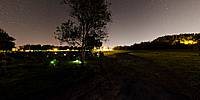The late astronomer, Carl Sagan, coined the statement that we are all "star stuff". He was referring to the the fact that virtually all elements in existence today were formed from the intense heat and pressure of exploding stars. Around 16 billion years ago, before there were any stars, the universe was made up of hydrogen and helium. Carbon and other heavier elements were made subsequently, over billions of years.
Stars are formed from nebulae and consist mostly of hydrogen and helium gas. The life cycle of a star depends on its mass. Stars live for millions to billions of years. The larger the mass the shorter its life cycle. The combination of fusion and increased gravity at the core cause elements to join creating heavier elements. With massive stars this continues until the core is so dense and the energy needed is so great it collapses into a supernova creating even more heavier elements.
Some of the material from the supernova will be collected to form yet another star. The first generation of stars were massive and made up only hydrogen and helium and produced the lighter elements. The second generation stars also contained some of the lighter elements, and every generation later created heavier elements. Our sun, Sol, is estimated to be a third generation star with an age of 4.5 billion years.
This means the carbon and other elements heavier than hydrogen and helium that we are made up of, were created in stars. And one day, the atoms we contain will most likely once again become parts of new stars.
In the mean time, enjoy life, it is the only one you got.
USA-Canada / Canada-New Brunswick
Lat: 45° 14' 20.56" N
Long: 67° 7' 3.81" W
Precision is: High. Pinpoints the exact spot.
6 around, 1 up, & 1 down
PTGui 9
I took a second set of images intended to capture more detail in the foreground illuminating with my smart phone and a blue colored screen. The blue light did not work. I only faintly blended in a bit to the nadir of the pano.
I did not scope out an exact spot to take the pano except I knew it was going to be one of three graveyards on this dark road near the ocean.
There was a much darker grave site but with only a few stones. I felt the lights decorating this site added to the pano. I moved furthest away from street lights and traffic as possible, then positioned the camera so trees hid the worst of the street lights.
There was a time as a kid I would not venture near a graveyard at night. Shooing this pano, my biggest fear was that someone with a car and headlights on would investigate on what I was doing and ruin my shot.




 Tap or click the zoom icon in the bottom right corner of the picture to switch between in-page and fullscreen view
Tap or click the zoom icon in the bottom right corner of the picture to switch between in-page and fullscreen view